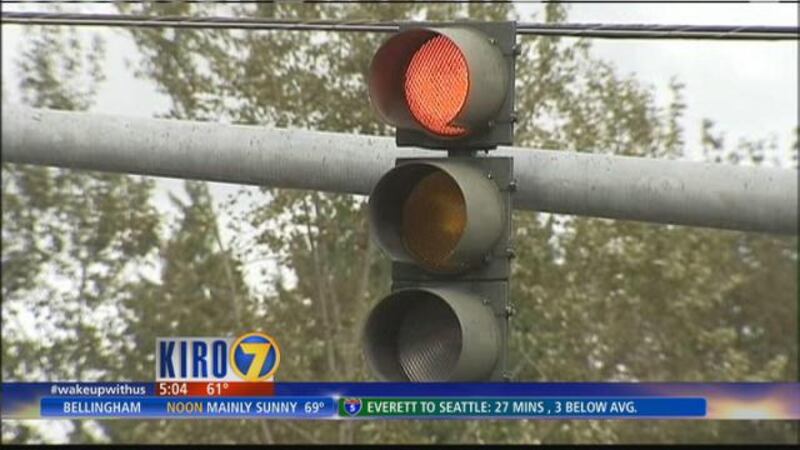Red lights are supposed to be timed to keep cars moving, but we've all been stopped at lights before with no cars in sight.
For KIRO 7's continued focus on transportation issues, Jeff Dubois asked for intersections where drivers think the lights could be better timed.
We heard from hundreds of people who commented on Facebook. A lot of people were disgusted by Mercer Street – hitting almost every light heading to I-5.
But there's another spot that causes blood pressures to rise in Mill Creek.
Mill Creek
Several drivers get stuck at State Route 527 and 164th Street Southeast in Mill Creek just about every day.
"Every day. Around 5 o'clock, 6 o'clock, it is horrible right here," said Will Dobson of Lynnwood.
So does Sean Spooner.
"There's a lot of honking and fingers and angry people. People are trying to go to work," said Spooner.
Drivers turning left from SR 527 toward I-5 get backed up into the intersection because the light ahead on 164th hasn't changed.
It comes down to who's running the traffic signals. The light on SR 527 is run by the state. The one on 164th is managed by Snohomish County, and the signals don't talk to each other.
The Washington State Department of Transportation says growth in the Mill Creek area has maxed-out the capacity of the intersection. Nearly 60,000 drivers go through it every day.
"We can't build our way out of this problem," said Travis Phelps with WSDOT.
But WSDOT and Snohomish County transportation officials are planning to install a new, adaptive traffic signal system on parts of State Route 527.
South Seattle
At First Avenue South and East Marginal Way in South Seattle, a few thousand cars every day have to sit and wait at a red light for minutes, while zero cars go through the intersection.
"It's kind of ridiculous. If no traffic's coming, you should be able to go," said driver Marcia Austin.
Drivers get stuck waiting for traffic coming off the First Avenue South Bridge. Only, there are no cars, because the bridge is up for boat traffic. The road is empty, even though the light's green to turn onto East Marginal Way. And the other drivers wait -- for two minutes.
The problem is that the traffic signal is operated by Seattle DOT, and the draw bridge is managed by the state DOT. And the systems aren't linked, though they could be.
SDOT knows about the problem. In fact, two years ago, they ran a test and engineers changed the cycle of the traffic light when the bridge was up. Engineers thought it was going to work great.
"But then when the bridge went down again, it took a long time for the two signals to sync up again, to synchronize and coordinate. It took multiple cycles, and the resulting delays were worse than keeping it as it currently is," said SDOT traffic engineer Dongho Chang.
Bellevue leading way on smarter traffic lights
Later Friday on KIRO 7 News from 5-6:30, reporter Graham Johnson looks into how one city is leading the way on smarter traffic lights.
Bellevue has the state's first "traffic adaptive signal system" that will be in place at all of its nearly 200 signalized intersections by the end of the year.
Cameras above intersections supplement sensors in the pavement to help a computer decide when to turn the lights green.
Watch from 5-6:30 p.m. Friday to see how much the system costs – and how in some cases, the system is a victim of its own success.
KIRO








